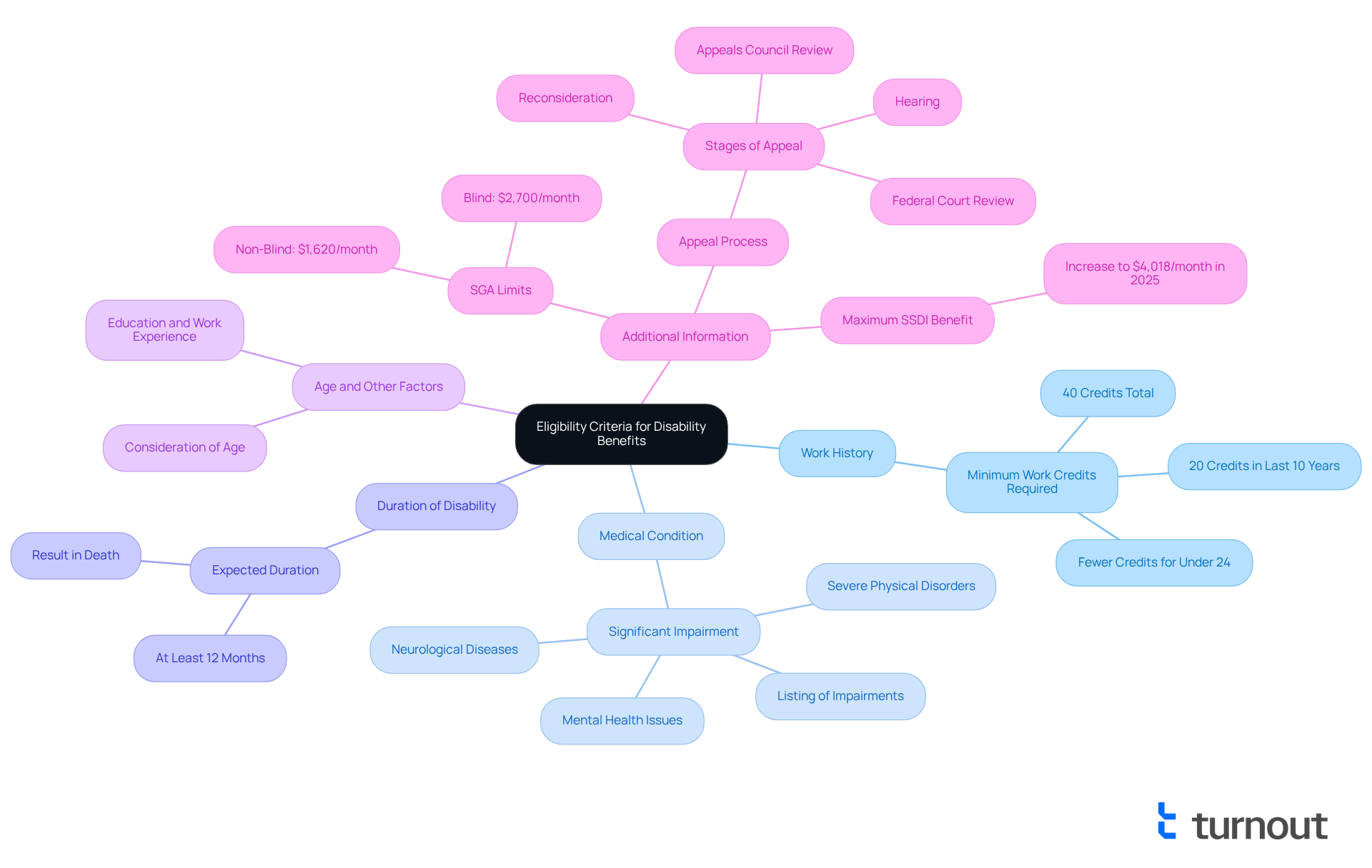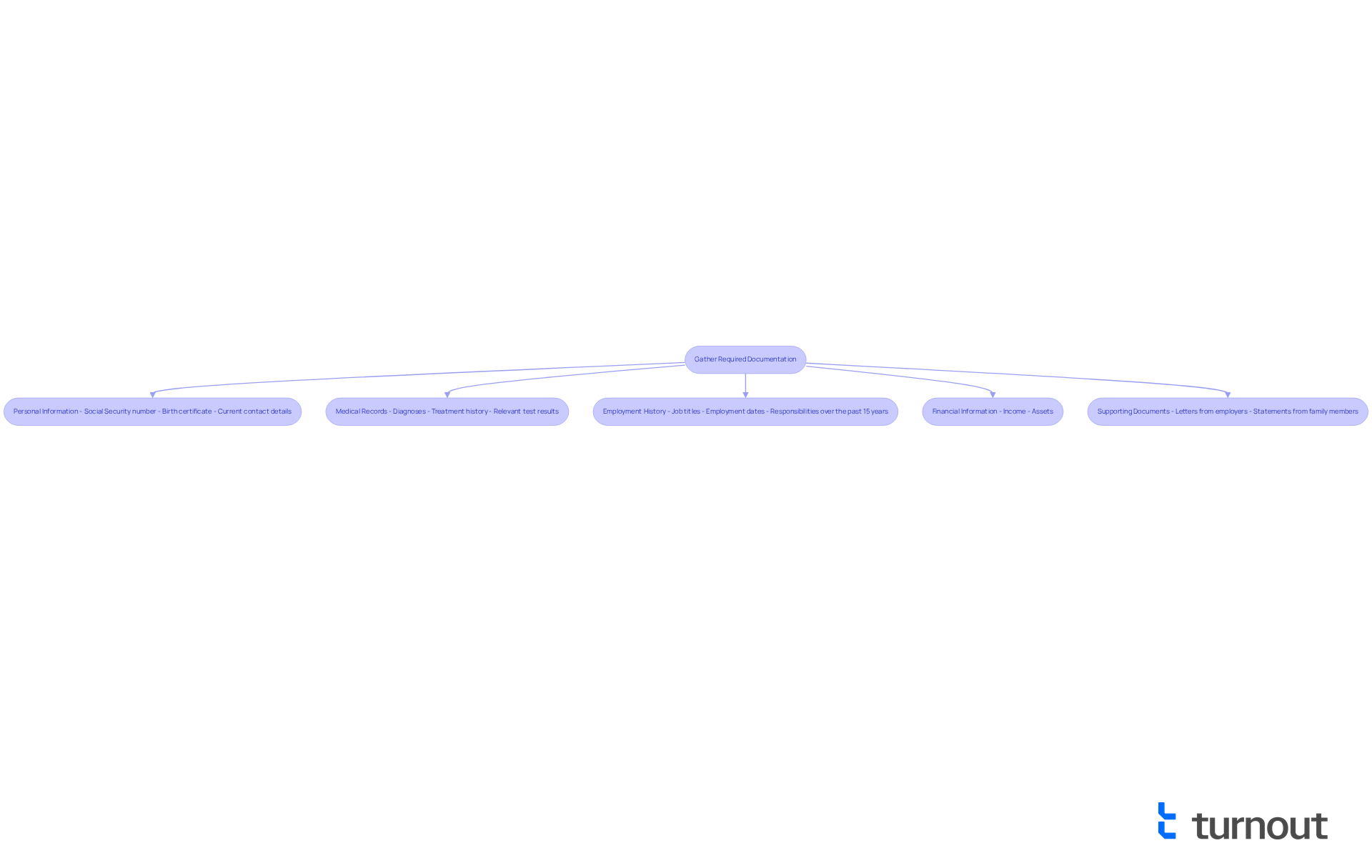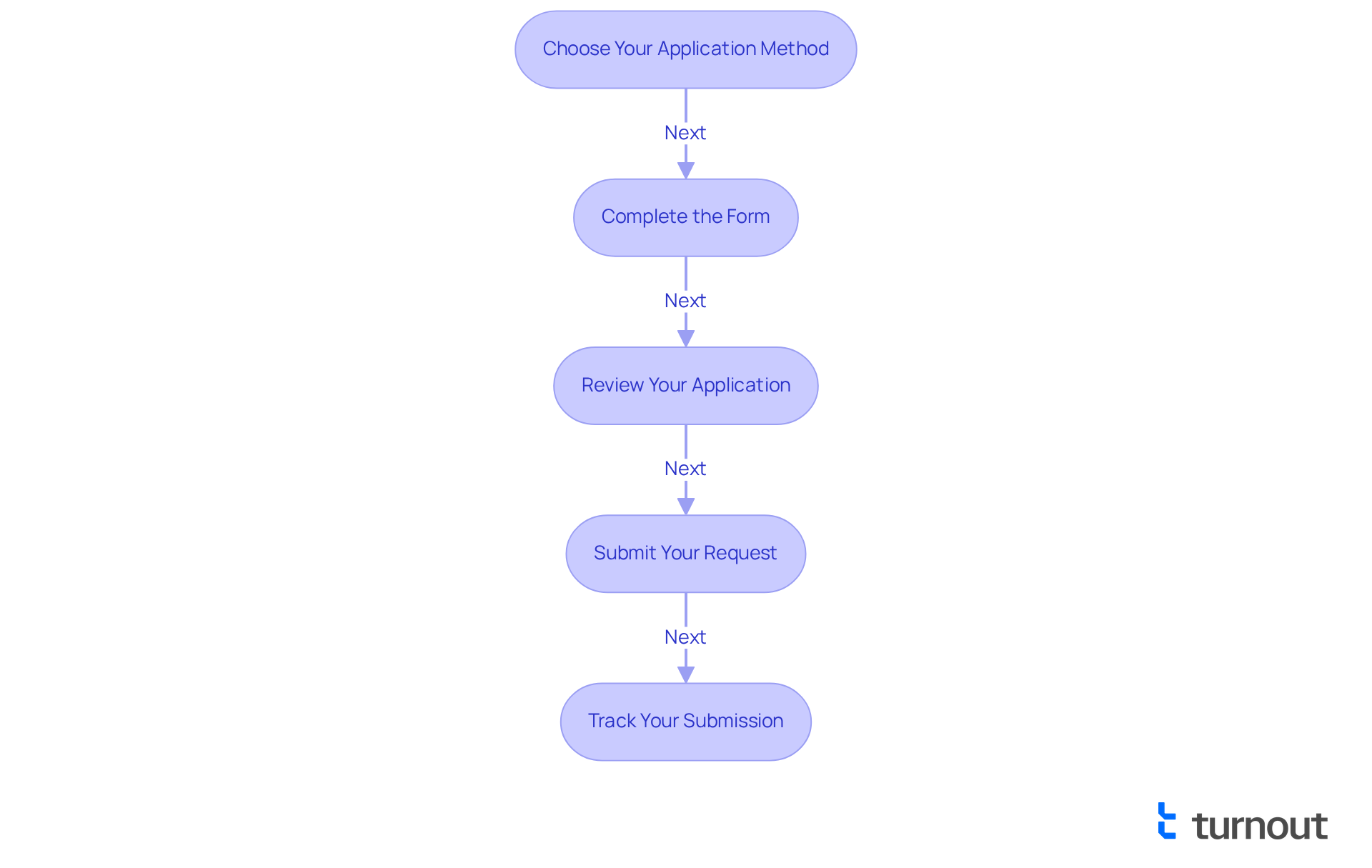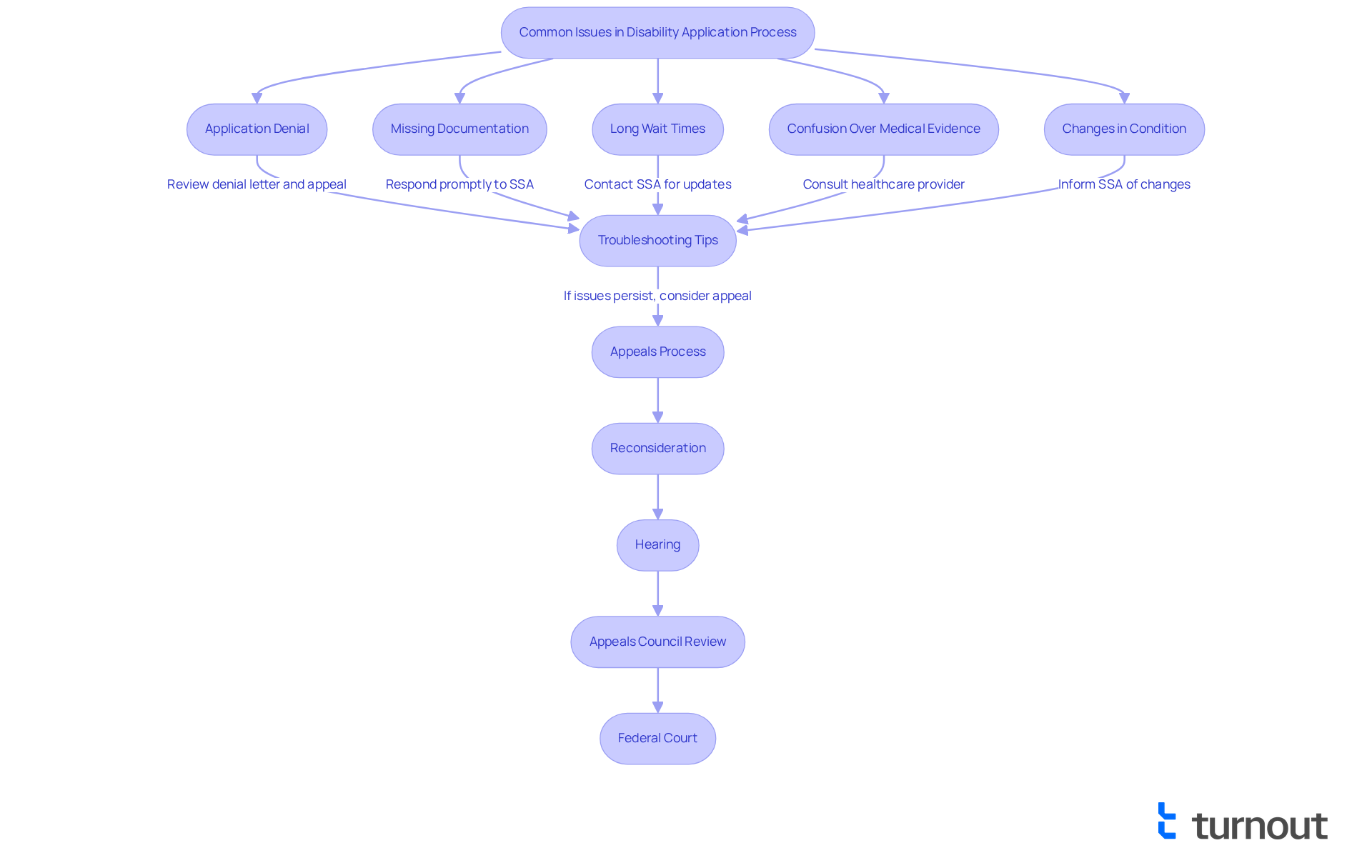Overview
Navigating the process of filing for disability benefits with Social Security can feel overwhelming. We understand that many individuals face challenges when seeking assistance. To help you on this journey, we outline four essential steps that can make this process smoother:
- Understanding eligibility criteria
- Gathering required documentation
- Completing and submitting the application
- Troubleshooting common issues
Each of these steps is crucial, and thorough preparation can significantly enhance your chances of approval. It's common to feel anxious, especially considering that a significant percentage of initial claims are denied due to incomplete information. By being aware of potential obstacles and preparing accordingly, you can approach this process with greater confidence.
Remember, you are not alone in this journey. We're here to help guide you through each step, ensuring you have the support you need. Take a moment to reflect on your situation and consider how these steps can assist you in successfully filing for your benefits.
Introduction
Navigating the complexities of filing for disability benefits with Social Security can feel overwhelming. We understand that this journey is often filled with uncertainty and confusion. It's crucial to grasp the eligibility criteria and necessary documentation for anyone seeking support, especially since nearly two-thirds of initial applications face denial.
What strategies can you employ to enhance your chances of success in this challenging process? This guide will explore essential steps and common pitfalls, reassuring you that you are not alone in this journey and equipping you with the knowledge needed to effectively navigate the Social Security disability application landscape.
Understand Eligibility Criteria for Disability Benefits
Navigating the process of filing disability with social security for benefits can feel overwhelming. We understand that this journey may be filled with uncertainty and concern. To help you, here are some critical factors to consider:
- Work History: Typically, you need to have worked in jobs covered by Social Security for at least five of the last ten years. In 2025, most applicants will require a total of 40 credits, with 20 of those accumulated in the last decade before your disability began. If you're under 24, you may qualify for SSDI with fewer work credits, depending on your age.
- Medical Condition: Your disability must be significant enough to prevent you from engaging in any substantial gainful activity (SGA). The SSA provides a detailed Listing of Impairments that outlines qualifying criteria, which may include severe physical disorders, mental health issues, and neurological diseases.
- Duration of Disability: The condition must be expected to last at least 12 months or result in death. This requirement ensures that benefits are reserved for those facing long-term disabilities.
- Age and Other Factors: The SSA also takes into account your age, education, and work experience, which can influence your ability to adapt to other types of work.
It's important to note that in 2025, the SGA limit for non-blind individuals will be set at $1,620 per month, while for those considered blind, it will rise to $2,700. Additionally, the maximum SSDI benefit amount will increase from $3,822 to $4,018 monthly. Approximately two-thirds of initial SSDI requests are denied, which highlights the importance of thoroughly understanding the criteria for filing disability with social security. If your claim is denied, remember that you have the right to appeal through a structured process that includes four stages: Reconsideration, Hearing, Appeals Council Review, and Federal Court Review.
For comprehensive information on qualifying medical issues, we encourage you to consult the SSA’s Blue Book. This resource can assist you in determining whether your situation meets their criteria. Furthermore, in 2025, a 2.5% cost-of-living adjustment (COLA) will be implemented, affecting SSDI payments. Understanding these details is crucial in the process of filing disability with social security to decide whether to move forward with your application. You are not alone in this journey, and we’re here to help you every step of the way.

Gather Required Documentation for Your Application
Navigating the process of filing disability with social security benefits can feel overwhelming, but we are here to assist you every step of the way. To make this journey smoother, it's essential to gather and organize the following documentation:
- Personal Information: Start with your Social Security number, birth certificate, and current contact details.
- Medical Records: Collect thorough medical records from your healthcare providers. This should encompass diagnoses, treatment history, and relevant test results that illustrate how your health status affects your ability to perform daily tasks. For example, note any limitations in your daily activities due to your condition.
- Employment History: Prepare a detailed record of your employment background, including job titles, employment dates, and descriptions of your responsibilities over the past 15 years. Be sure to highlight any specific work limitations or changes in your situation over time.
- Financial Information: Document your income and assets, as this information may be necessary to assess your financial need for benefits.
- Supporting Documents: Gather any additional documents that could strengthen your claim, such as letters from employers or statements from family members regarding your condition.
Arranging these documents in a dedicated folder will allow for easy access when finalizing your submission. While the time it takes to gather the required documentation can vary, being meticulous in your preparation can significantly enhance your chances of approval. Supporters emphasize that having well-organized documentation is vital for navigating the complexities of filing disability with social security, a process that typically takes 3-5 months for evaluation. It's important to remember that around 65-70% of initial SSDI requests are denied, often due to incomplete information, so thoroughness is key. If your request is denied, know that you have the right to contest the decision through various levels, including reconsideration and federal court review. Promptly responding to any inquiries from the SSA is crucial to avoid delays in your processing. You are not alone in this journey, and taking these steps can help pave the way to the support you need.

Complete and Submit Your Disability Application
To successfully complete and submit your Social Security Disability application, we invite you to follow these essential steps:
-
Choose Your Application Method: You have the option to apply online through the SSA website, by phone, or in person at your local SSA office. Applying online is often quicker, significantly reducing wait times compared to in-person submissions. The Social Security Administration has simplified the process, allowing for faster initial claim decisions.
-
Complete the Form: As you fill out the form, please take your time to provide accurate information about your health status, employment history, and personal details. It's crucial to be thorough and honest, as incomplete or incorrect submissions can lead to delays or rejections. Remember, common mistakes in the process of filing disability with social security include not providing complete medical records or failing to explain how your condition impacts your ability to work.
-
Review Your Application: Before you submit, take a moment to meticulously double-check all the information for accuracy. Ensure that all necessary documents are included, as missing paperwork is a frequent cause of errors. With around 7.4 million Americans receiving SSI each month, a well-prepared submission is vital for your success.
-
Submit Your Request: If you're applying online, simply follow the prompts to send your request. For mail submissions, send your documents to the appropriate SSA office and keep a copy of everything for your records. The SSA has also introduced an online form for Supplemental Security Income (SSI) benefits, making the process even easier.
-
Track Your Submission: After sending your application, you can monitor its status online or by contacting the SSA. Staying informed about your submission will help you respond promptly to any requests for additional information. While processing times can vary, understanding this timeline can help you set realistic expectations.
By following these steps for filing disability with social security, you can navigate the process more effectively and increase your chances of a successful outcome. Many candidates have successfully maneuvered through the SSA submission process by being meticulous and proactive. Remember, you are not alone in this journey, and we’re here to help you every step of the way.

Troubleshoot Common Issues During the Application Process
Navigating the application process for filing disability with Social Security can be challenging, and it's common to encounter obstacles along the way. Here are some common issues applicants face and how to troubleshoot them:
-
Application Denial: If your application is denied, we understand how disheartening that can be. Review the denial letter carefully; it will detail the reasons for refusal, which may include inadequate medical evidence or misconceptions about your situation. You can appeal the decision by following the instructions provided in the letter. Remember, the appeals process offers multiple opportunities to overturn the decision, so don’t lose hope.
-
Missing Documentation: When the SSA requests additional information, it’s vital to respond promptly. Ensure you provide the requested documents and any necessary explanations. Missing documentation is a frequent reason for delays and denials, so thoroughness is crucial in this process.
-
Long Wait Times: It’s common to feel frustrated by long wait times. The average wait for an initial disability decision is approximately 232 days, and if denied, you may wait an additional 450 days for a hearing. If you experience long wait times, consider contacting the SSA for an update. While patience is essential, being proactive can help keep your case moving.
-
Confusion Over Medical Evidence: Many applicants feel unsure about the medical evidence required to support their claims. Consulting with your healthcare provider or a disability advocate can provide clarity on what documentation is necessary. Strengthening your medical evidence with detailed statements from treating physicians, including updated medical records and a narrative letter, can significantly improve your chances of success.
-
Changes in Condition: If your medical condition worsens after applying, it’s important to inform the SSA. Changes in your health status can affect your eligibility and the benefits you may receive. Keeping the SSA updated ensures that your case reflects your current situation.
By being aware of these common issues and knowing how to address them, you can navigate the process of filing disability with Social Security more effectively and increase your chances of securing the benefits you deserve. Additionally, it's important to note that the appeal process consists of four levels: reconsideration, hearing, appeals council review, and federal court, each with its own requirements and timelines. Remember, you are not alone in this journey; we’re here to help you every step of the way.

Conclusion
Navigating the process of filing for disability with Social Security can feel overwhelming. We understand that it requires a comprehensive understanding of eligibility criteria, meticulous documentation, and careful submission. By familiarizing yourself with these requirements, you can significantly enhance your chances of receiving the benefits you need. While this journey may seem complex, it is manageable with the right information and support.
Key components of this process include:
- Understanding eligibility criteria
- Gathering necessary documentation
- Accurately completing the application
- Addressing common issues that may arise
Each step is crucial. It’s common for initial applications to be denied due to incomplete information or misunderstandings of the requirements. Therefore, thorough preparation is vital, as it directly impacts your likelihood of approval.
Ultimately, securing Social Security disability benefits is not just about following steps; it’s about advocating for yourself and seeking the support you need throughout this journey. By taking proactive measures, staying informed about potential challenges, and utilizing available resources, you can navigate the complexities of the system with confidence. Remember, empowerment through knowledge and preparation is essential for achieving a successful outcome in this critical endeavor. You are not alone in this journey; we’re here to help.
Frequently Asked Questions
What is the work history requirement for disability benefits?
Typically, you need to have worked in jobs covered by Social Security for at least five of the last ten years. In 2025, most applicants will require a total of 40 credits, with 20 of those accumulated in the last decade before your disability began. If you're under 24, you may qualify for SSDI with fewer work credits, depending on your age.
What medical conditions qualify for disability benefits?
Your disability must be significant enough to prevent you from engaging in any substantial gainful activity (SGA). The SSA provides a Listing of Impairments that outlines qualifying criteria, which may include severe physical disorders, mental health issues, and neurological diseases.
How long must a disability last to qualify for benefits?
The condition must be expected to last at least 12 months or result in death. This requirement ensures that benefits are reserved for those facing long-term disabilities.
What other factors does the SSA consider when evaluating disability claims?
The SSA takes into account your age, education, and work experience, which can influence your ability to adapt to other types of work.
What are the SGA limits for 2025?
In 2025, the SGA limit for non-blind individuals will be set at $1,620 per month, while for those considered blind, it will rise to $2,700.
What is the maximum SSDI benefit amount in 2025?
The maximum SSDI benefit amount will increase from $3,822 to $4,018 monthly in 2025.
What percentage of initial SSDI requests are denied?
Approximately two-thirds of initial SSDI requests are denied, highlighting the importance of thoroughly understanding the criteria for filing disability with social security.
What should I do if my disability claim is denied?
If your claim is denied, you have the right to appeal through a structured process that includes four stages: Reconsideration, Hearing, Appeals Council Review, and Federal Court Review.
Where can I find comprehensive information on qualifying medical issues?
For comprehensive information on qualifying medical issues, you can consult the SSA’s Blue Book, which can assist you in determining whether your situation meets their criteria.
Will there be any changes to SSDI payments in 2025?
Yes, in 2025, a 2.5% cost-of-living adjustment (COLA) will be implemented, affecting SSDI payments.




